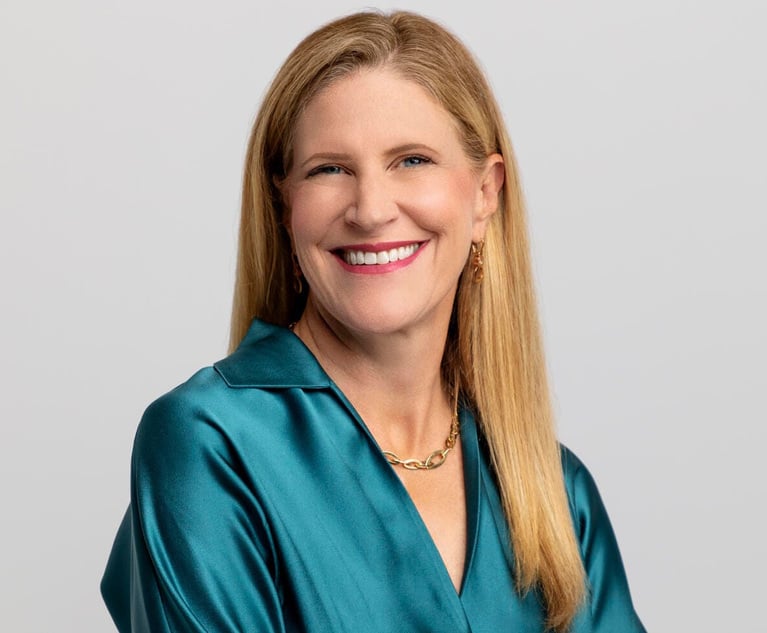HR's #MeToo Dilemma: How Much to Say About That Fired Employee?
"The inclination both culturally and legally for companies was historically not to publicize reasons for employees or executives leaving the company," one lawyer tells Corporate Counsel.
January 23, 2018 at 05:19 PM
7 minute read

The wave of sexual harassment allegations in corporate America has put a new focus on human resource departments and forced companies to decide how much information—if any at all—should be revealed to the public about employee misconduct.
Companies face tricky questions over what they can say publicly about an employee who's resigned or been fired. Personnel matters once relegated to quiet, internal proceedings are now being highlighted in headlines.
Amid the public attention from the #MeToo movement, there's new pressure for greater transparency about the facts underlying alleged misconduct and how workplace allegations were resolved. Management-side lawyers say companies should consider liability, the potential for defamation and possible litigation—as well as public relations—when faced with how to publicly respond to questions about an employee who's been let go.
“The inclination both culturally and legally for companies was historically not to publicize reasons for employees or executives leaving the company,” said Jay Holland, chairman of Joseph, Laake & Greenwald's labor and employment practice. “Culturally, companies want HR practices to stay within the company. Legally, they don't want to be skewed by former employees that they were defamed.”
Morgan Stanley on Monday issued a rare statement disputing reports—first published in December—that former Rep. Harold Ford Jr., an executive there, faced sexual misconduct claims. He was terminated for “corporate policy,” the bank told reporters in a statement. A lawyer for Ford, Beth Wilkinson of Washington's Wilkinson Walsh + Eskovitz, didn't return a message seeking comment. Ford denied sexual misconduct claims in December in a series of tweets.
When Bank of America terminated executive Omeed Malik, the company reportedly declined to comment about the circumstances, other than saying he was no longer an employee there. A Bank of America representative was not immediately reached for comment Tuesday.
The New York Times reported Malik's separation was rooted in an internal harassment investigation and accusations that Malik behaved inappropriately. Bloomberg reported this week that executives instructed sales staff to tell clients Malik was pursuing another opportunity. Women at the bank were reportedly angered after a Reuters report—about Malik's departure—did not mention any reason for his leaving BofA.
A lawyer for Malik, Mark Lerner, chairman of the employment and litigation group at Kasowitz Benson Torres, declined to comment Tuesday. Malik formerly was an attorney at Weil, Gotshal & Manges.
Holland said that any atmosphere where speculation is rampant will compel more examples of companies providing clarifications about why a particular personnel decision was made.
“There are a host of reasons why individuals leave their work. The vast majority of the time it has nothing to do with harassment,” he said. “It's not necessarily fair to the employer or employee for speculation to be out there, if it's true or if it's not.”
He said the inclination to remain silent or neutral may be the best move for companies. He said the corporate public relations and general counsel offices must consider carefully responding, particularly if it could be a defendant in a sexual harassment case over its employee. Any statements made public could be used if litigation ensues, he said.
Samia Kirmani, a Jackson Lewis principal who focuses on workplace training, said how companies publicly respond has been a laser-focused discussion topic in recent months. Many companies, responding to public pressure, have been reactionary, and some even issue statements or respond before an investigation has taken place, she said.
“What we have been seeing is companies immediately firing or issuing statements,” Kirmani said. “Companies are struggling with needing to come out strong to their commitment to a healthy workplace. That is totally an appropriate response. At the same time, do they need to make a statement why someone was fired? Employers have to be really conscious and deliberate about what they are saying.”
She said a failure to say something about why someone was terminated is not necessarily an effort to slip something under the rug or serve a nefarious purpose. She cautioned that employers should not rush to respond in the media. Rather, they should have an ongoing dialogue with public relations and human resources before a crisis arises.
Notice to a New Employer
Holland said for prospective employers, most large employers adopt neutral reference policies. He said that a former employer offering a reference and not alluding to the allegation of sexual harassment could also be a liability issue.
“I think we will see that question arise more and more,” he said. “Could a woman sue that employee's former employer for failing to provide notice to the new employer? That's an important question.”
Mark Konkel, a labor and employment partner at Kelley Drye & Warren, said companies are facing two distinct forms of pressure: being open about concerns of women in the workplace and grappling with “an uneasy sense that the #MeToo movement might go too far.” Companies, he said, must make sure any response to alleged misconduct involves an investigation and due process.
Addressing workplace misconduct concerns could mean being open about what the problems were, and how a company responded to allegations against the employee. He said companies have also begun to grapple with employees who have lost their jobs without any real investigation or due process.
Companies are taking different approaches amid the public pressure, Konkel said. They too either become a black box, revealing nothing, or make it clear that sexually inappropriate conduct wasn't part of the decision.
“I have seen a few careers destroyed at this point not because someone engaged in sexual harassment, but because a mere allegation tainted the employee—and the employer reacted by protecting its brand, erring on the side of abundant caution, and terminating the employee,” Konkel said. “That's a problem in that it doesn't just credit the female employee with 'I believe you'; it positively discredits the 'accused' without giving him any real ability to understand what allegations he is facing or providing him with an ability to respond.”
Read more:
Microsoft, Nodding to '#MeToo,' Says It Won't Keep Harassment Victims Out of Court
Big Firms Pick Up #MeToo Work for State Legislatures
Matt Lauer's Accuser Has a Veteran Washington Civil Rights Lawyer on Her Side
Even the Tax Bill Confronts Sexual Harassment in the Workplace
How Companies Can Avoid Pitfalls of a Bad Sexual Harassment Policy
Kirkland Partner, Trump Pick for Top Labor Lawyer, Calls Arbitration Reach 'Problematic'
This content has been archived. It is available through our partners, LexisNexis® and Bloomberg Law.
To view this content, please continue to their sites.
Not a Lexis Subscriber?
Subscribe Now
Not a Bloomberg Law Subscriber?
Subscribe Now
NOT FOR REPRINT
© 2025 ALM Global, LLC, All Rights Reserved. Request academic re-use from www.copyright.com. All other uses, submit a request to [email protected]. For more information visit Asset & Logo Licensing.
You Might Like
View All
Former Capital One Deputy GC Takes Legal Reins of AIG Spinoff

Khan Defends FTC Tenure, Does Not Address Post-Inauguration Plans

Apple Disputes 'Efforts to Manufacture' Imaging Sensor Claims Against iPhone 15 Technology
Trending Stories
Who Got The Work
Michael G. Bongiorno, Andrew Scott Dulberg and Elizabeth E. Driscoll from Wilmer Cutler Pickering Hale and Dorr have stepped in to represent Symbotic Inc., an A.I.-enabled technology platform that focuses on increasing supply chain efficiency, and other defendants in a pending shareholder derivative lawsuit. The case, filed Oct. 2 in Massachusetts District Court by the Brown Law Firm on behalf of Stephen Austen, accuses certain officers and directors of misleading investors in regard to Symbotic's potential for margin growth by failing to disclose that the company was not equipped to timely deploy its systems or manage expenses through project delays. The case, assigned to U.S. District Judge Nathaniel M. Gorton, is 1:24-cv-12522, Austen v. Cohen et al.
Who Got The Work
Edmund Polubinski and Marie Killmond of Davis Polk & Wardwell have entered appearances for data platform software development company MongoDB and other defendants in a pending shareholder derivative lawsuit. The action, filed Oct. 7 in New York Southern District Court by the Brown Law Firm, accuses the company's directors and/or officers of falsely expressing confidence in the company’s restructuring of its sales incentive plan and downplaying the severity of decreases in its upfront commitments. The case is 1:24-cv-07594, Roy v. Ittycheria et al.
Who Got The Work
Amy O. Bruchs and Kurt F. Ellison of Michael Best & Friedrich have entered appearances for Epic Systems Corp. in a pending employment discrimination lawsuit. The suit was filed Sept. 7 in Wisconsin Western District Court by Levine Eisberner LLC and Siri & Glimstad on behalf of a project manager who claims that he was wrongfully terminated after applying for a religious exemption to the defendant's COVID-19 vaccine mandate. The case, assigned to U.S. Magistrate Judge Anita Marie Boor, is 3:24-cv-00630, Secker, Nathan v. Epic Systems Corporation.
Who Got The Work
David X. Sullivan, Thomas J. Finn and Gregory A. Hall from McCarter & English have entered appearances for Sunrun Installation Services in a pending civil rights lawsuit. The complaint was filed Sept. 4 in Connecticut District Court by attorney Robert M. Berke on behalf of former employee George Edward Steins, who was arrested and charged with employing an unregistered home improvement salesperson. The complaint alleges that had Sunrun informed the Connecticut Department of Consumer Protection that the plaintiff's employment had ended in 2017 and that he no longer held Sunrun's home improvement contractor license, he would not have been hit with charges, which were dismissed in May 2024. The case, assigned to U.S. District Judge Jeffrey A. Meyer, is 3:24-cv-01423, Steins v. Sunrun, Inc. et al.
Who Got The Work
Greenberg Traurig shareholder Joshua L. Raskin has entered an appearance for boohoo.com UK Ltd. in a pending patent infringement lawsuit. The suit, filed Sept. 3 in Texas Eastern District Court by Rozier Hardt McDonough on behalf of Alto Dynamics, asserts five patents related to an online shopping platform. The case, assigned to U.S. District Judge Rodney Gilstrap, is 2:24-cv-00719, Alto Dynamics, LLC v. boohoo.com UK Limited.
Featured Firms
Law Offices of Gary Martin Hays & Associates, P.C.
(470) 294-1674
Law Offices of Mark E. Salomone
(857) 444-6468
Smith & Hassler
(713) 739-1250







